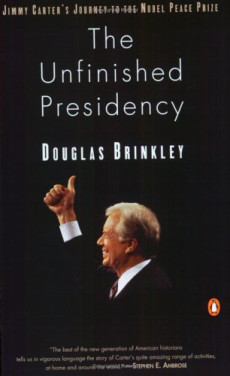Many of us will confront a luxury that our parents and grandparents never dreamed possible: the opportunity to create and live a “second act” of our adult lives. Retirement was once a brief window, enjoyed by the few and often filled with travel, television, and tedium. Now, as people retire earlier and live longer, many are discovering that there are two, three, or even four decades to fill.
Ideally, older people would watch the curtain rise on Act 2. Yet many Americans are failing miserably at creating a second life. A doctor friend of mine at a private clinic in Vail, Colo., reports that the leading prescription drug for wealthy retirees is antidepressants and the biggest family counseling problem is alcoholism. Rather than seizing the opportunity to use the wisdom of age and experience to redefine themselves, many Americans choose to languish. For those interested in staging a second act, I strongly encourage reading The Unfinished Presidency, a stunningly inspiring and entertaining account of President Jimmy Carter’s “journey beyond the White House.” Noted historian Douglas G. Brinkley provides an account in depth of Carter’s resurrection from a failed one-term President to a widely respected, globe-trotting do-gooder.
The ashes from which this phoenix rose were formidable. Three major failures marked Carter’s presidency: 52 American hostages held for more than a year in Iran; an inflation rate of 13.5 percent; and unemployment of 7.5 percent. The nation felt humiliated by the Iran situation, and the economic conditions were so bad that presidential candidate Ronald Reagan talked of a “misery index” that was calculated by adding together the inflation and unemployment rates.
It would have been easy for Carter to retreat to a dark corner and quietly lick his wounds. Or perhaps follow President Gerald Ford’s example and retire to the golf course. Carter, however, chose to find his redemption through action. With wife Rosalynn by his side, he donned coveralls and hammered nails on Habitat for Humanity building projects and launched the Carter Center in Atlanta. He flew (commercial!) to locations from Africa to Latin America to supervise elections and agitated for Middle East peace in various power centers. He launched an ambitious drive to wipe the treacherous guinea worm off the face of the Earth and age 69 summited Mount Fuji. Never had the world seen such a peripatetic ex- President, nor one so devoted to helping create a more just and peaceful world.
I often consulted this book during my own journey of discovery. I spent Act 1 of my adult life working for nearly a decade at Microsoft Corp. For Act 2, I dreamed of launching an NGO (Room to Read) that would bring books and libraries to millions children across the developing world. But was fearful of the loss of income and status that would be the doppelganger to this move. And then Brinkley’s book struck me like a gauntlet: If Carter could find a meaningful life after being the most powerful man on Earth, then what was to stop a mid-level 35-year-old executive from doing the same?
Many of us will have the great good fortune to have time for a second act, to do what my friend Dipak Jain, dean of Northwestern University’s Kellogg School of Management, calls “moving from success to significance.” We would do well to learn all we can from Carter’s inspiring example. By reading (or rereading) this book, all of us can aspire to aim high while contemplating our next acts.


